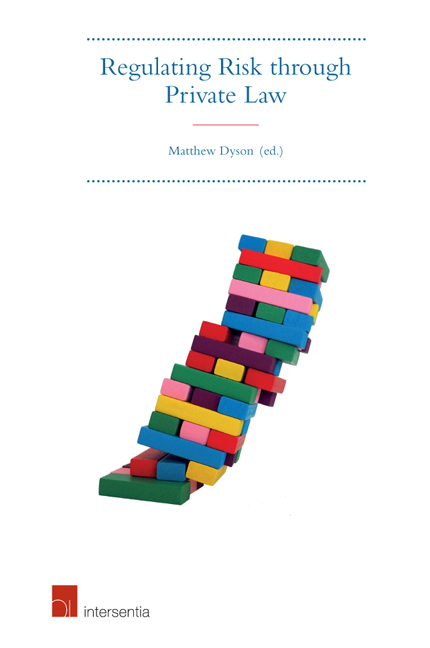Book contents
- Frontmatter
- Preface
- Contents
- Table of Cases
- List of Contributors
- Chapter 1 Introduction
- Part I Risk Overviews
- Part II State of the national art on risk
- Chapter 11 Legal Risk in International Commercial Disputes
- Chapter 12 Medical Accidents and Pharmaceutical Product Liability in France
- Chapter 13 Bearing and Sharing Risk in the Swedish Welfare State
- Chapter 14 Modernisation and Risk Regulation in the Italian Food Sector
- Chapter 15 Motor Vehicle Accidents Caused by Game Wandering onto Spanish Roads
- Chapter 16 Dutch Tort Law at the Crossroads: Judicial Regulation of Health and Environmental Risks
- Chapter 17 Sub Terra: Risk in the Chilean Mining Industry
- Chapter 18 Constitutionalising Rights and Reacting to Risk in South Africa
- Chapter 19 Regulating Risk in Brazil: Resort to General Clauses
- Chapter 20 What does Risk-Reasoning do in Tort Law?
- Chapter 21 Epilogue: What does Risk-Reasoning Tell Us about Tort Law?
- Index
- About the Editor
Chapter 21 - Epilogue: What does Risk-Reasoning Tell Us about Tort Law?
from Part II - State of the national art on risk
Published online by Cambridge University Press: 13 October 2018
- Frontmatter
- Preface
- Contents
- Table of Cases
- List of Contributors
- Chapter 1 Introduction
- Part I Risk Overviews
- Part II State of the national art on risk
- Chapter 11 Legal Risk in International Commercial Disputes
- Chapter 12 Medical Accidents and Pharmaceutical Product Liability in France
- Chapter 13 Bearing and Sharing Risk in the Swedish Welfare State
- Chapter 14 Modernisation and Risk Regulation in the Italian Food Sector
- Chapter 15 Motor Vehicle Accidents Caused by Game Wandering onto Spanish Roads
- Chapter 16 Dutch Tort Law at the Crossroads: Judicial Regulation of Health and Environmental Risks
- Chapter 17 Sub Terra: Risk in the Chilean Mining Industry
- Chapter 18 Constitutionalising Rights and Reacting to Risk in South Africa
- Chapter 19 Regulating Risk in Brazil: Resort to General Clauses
- Chapter 20 What does Risk-Reasoning do in Tort Law?
- Chapter 21 Epilogue: What does Risk-Reasoning Tell Us about Tort Law?
- Index
- About the Editor
Summary
RISK-BASED REASONING IN TORT
In his concluding chapter, Matthew Dyson has clearly identified the core question addressed by the contributions to this volume: what does risk-based reasoning do for tort law? Doubtless there is no single neat answer to this question, and the answers suggested by the chapters are rich and fascinating in their variety. Of course, behind the question is a prior one – what is meant by ‘risk-based reasoning’? In his introduction and conclusion, Dyson points out that most, if not all, of the core questions of tort law can be and have been expressed in terms of risk. In this way, the language of risk has indeed become pervasive, at least in certain areas of the law of tort – some limits to the terrain on which this pervasiveness can be observed are explored below. He goes on to identify a number of reasons why it may be that the language of risk is so widely used. For example, he asks whether it is because this language is new (perhaps suggesting that it offers an escape from questions that have proved unanswerable, or can cut through language that has led to an impasse)? Or because it offers flexibility? Flexibility, certainly, has been a distinct characteristic of modern tort reasoning, and the conclusion to this epilogue argues that features of tort law which are linked to its flexibility (for example, its openness to policy reasons) are indeed compatible with the spread of risk-based reasoning.
First, however, I would suggest – in reinforcement of these observations – that ‘risk-based reasoning’ is so oft en adopted because it is a means of translating normatively difficult questions, whose language does not easily enable a satisfactory answer, into reworked and more answerable questions. It is possible that some traditional tort concepts such as fault are diluted, or at least altered, in making this translation, and this is further touched on below. Arguably, the history of risk demonstrates that the core reason for its prevalence is that it has as its very purpose the facilitation of answers. In other words, risk-based reasoning may be deployed in different contexts because of its connection not with a particular kind of problem, but with routes to finding solutions to a broader range of issues.
- Type
- Chapter
- Information
- Regulating Risk through Private Law , pp. 513 - 522Publisher: IntersentiaPrint publication year: 2018



